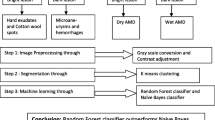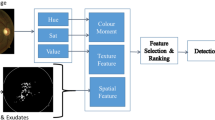Abstract
Diabetic Retinopathy is the major cause of blindness for diabetics in which the retina is damaged. Regular screening system help in detecting the early symptoms like exudates, which are due to the leakage of blood pressure of vessels. The significant role of proposed system is detecting the hard exudates in prevention of visual loss and blindness. Many researchers studied and investigated about detecting the exudates region but not satisfied with their results. Fundamental medical image processing steps with different techniques are implemented by the proposed system. Random Forest is a novel classification which is applied on color retinal images able to classify cluster of data with high accuracy. The performance of the proposed system is obtained by analyzing the accuracy obtained from the Random Forest classifier. These images are obtained from Diabetic Retinopathy Database (DIARETDB) database. The simulation results are obtained with the help of MATLAB 2018. By applying novel classification techniques improves the automatic detection of hard exudates from color retinal images. The achieved accuracy is compared with existing classifiers since the proposed Random Forest classifier provides the accuracy of 99.89% applied on color retinal images.










Similar content being viewed by others
References
Carrera, E., Andres, G., and Carrera, R., Automated detection of Diabetic Retinopathy using SVM. In Electronics, Electrical Engineering and Computing, IEEE, pp. 1-4, 2017.
Marin, D., Gegundaz, A., Garrido, F., Vasello, J., Ponte, V., and Bravo, M., An exudates detection method for diagnosis risk of diabetic macular edema in retinal images using Feature based and Supervised classification. Medical and biological Engineering and Computing, Springer, pp.1-4, 2018.
Dheeba, J., and Singh, N., Detection of Hard exudates in color fundus images using fuzzy support vector machine based expert system. Journal of Digital imaging, Springer, pp.761-768, 2015.
Roy, A., Dutta, D., Bhattacharya, P., and Choudhury, S., Filter and fuzzy C means based feature extraction and classification of diabetic retinopathy using support vector machine. Interference Conference on Communication and Signal Processing, IEEE, pp.6-8, 2017.
Rajput, G. and Preethi, N., Detection and classification of exudates using K-means clustering in color retinal images. International Conference on Signals and Image Processing, IEEE, pp.126-130, 2014.
ElTanboly, A., Ghazal, M., Khalil, A., Shalaby, A., Mahmoud, A., El-Azab, M., Schaal, S., and Baz, E., An integrated framework for automatic clinical assessment of diabetic retinopathy grade using spectral domain OCT images. In Biomedical imaging, IEEE, pp.1431-1435, 2018.
Agurto, C., Yu, H., Wigdahl, J., Pattichis, M., Nemeth, S., Barrigo, S., and Soliz, P., A multiscale optimization approach to detect exudates in the macula. IEEE Journal of Biomedical Healty Informatics 18(4):1328–1336, 2014.
Akram, U., Khalid, S., Tariq, A., Khan, S., and Azam, F., Detection and classification of retinal lesions for grading of diabetic retinopathy. Computers in Biology and Medicine, Elsevier, pp.161-171, 2014.
Dutta, S., Manideep, B., Basha, S., Caytiles, D., and Iyenagar, N., Classification of diabetic retinopathy images by using deep learning models. International Journal of Grid and Distributed Computing, Springer 11(1):89–106, 2018.
Yavuz, Z., and Kose, C., Blood vessel segmentation from retinal images based on enhancement methods. Signal processing and Communications applications, IEEE, pp. 907-910, 2014.
Chand, R., and Dheeba, J., Automatic Detection of Exudates in color fundus retinopathy images. Indian J. Sci. Technol., 8(26):1–6, 2015.
Meshram, S. P., and Pawar, M. S., Extraction of retinal blood vessels from diabetic retinopathy imagery using contrast limited adaptive histogram equalization. Int J Adv Comput Theory Eng, 2(3): 143–147, 2013.
Akiyama, S. D., Kishi, S., Matsumoto, H., Observation of neovascularization of the disc associated with proliferative diabetic retinopathy using OCT angiography”, Springer, pp. 1-6, 2018.
Walter, T., Klein, J., Massin, P., and Erginay, A., A contribution of image processing to the diagnosis of diabetic retinopathy detection of exudates in color fundus images of the human retina. IEEE Trans. Med. Imaging:1236–1243, 2002.
Giancardo, M., Karnowski, G. S., Tobin, K., and Chaum, E., Exudates based diabetic macular edema detection in fundus images. Med. Image Anal.:216–226, 2012.
Basha, S. S., Prasad, K. S., and Automatic detection of hard exudates in diabetic retinopathy using morphological segmentation and fuzzy logic, pp. 211–218, 2008.
Kussakunniran, W., Rithipravat, P., and Zhang J., Hard exudates segmentation based on learned initial seeds and iterative graph. Computer methods and programs in biomedicine, Elsevier, pp.173-183, 2018.
Bhargavi, R., and Rajesh, V., Exudate detection and feature extraction using active contour model and SIFT in color fundus images. J. Eng. Appl. Sci.:2362–2365, 2015.
Adem, K., Exudate detection for diabetic retinopathy with circular hough transformation and convolutional neural networks. Elsevier, pp. 289-295, 2018.
Amin, Y., Sarif, M., Ali, H., and Fernades, S. L., “A method for the detection and classification of diabetic retinopathy using structural predictors of bright lesions”, Journal of Computational science, Elsevier, pp. 153-164, (2017).
Kayal, D., and Banerjee, S., Detection of hard exudates using 2D Otsu algorithm in digital retinal fundus image. CSI Transactions on ICT, 5(1):53–57, 2017.
Tjandrasa, H., Putra, R., Wijaya, A., and Arieshanti, I., Classification of non-proliferative diabetic retinopathy based on hard exudates using soft margin SVM. IEEE Conference on control system, computing and Engineering, 2013.
Poonam, R., Manza, R., and Jonatham, P., Computer aided hard exudates detection on digital fundus images using morphology and multi-resolution analysis. International Journal of advanced computer technology. pp. 20-27.
Asha, G., Nasiha, A., Jayaram, M. A., and Manjunath, A., Exudates detection in retinal images using Back Propagation Neural network. Int. J. Comput. Appl. 25, 2011.
Al-Bander, B., Al-Nuaimy, W., Al-Taee, M. A., Williams, B. M., & Zheng, Y., Diabetic macular edema grading based on Deep neural network. Iowa Research Opthalmic Medical Image Analysis:121–128, 2016.
Pratt, H., Coenen, F., Broadbent, D., Harding, S., and Zheng, Y., Convolutional Neural Networks for diabetic retinopathy. International Conference on Medical Imaging:200–205, 2016.
Garcia, M., Sanchez, C. I, Poza, J., Lopez, M. I., and Hornero, R., Detection of hard exudates in retinal images using a Radial Basis Function Classifier. Ann. Biomed. Eng. 37(7):1448–1463, 2009.
Amel, F., Mohammed, M., & Abdelhafid B., Improvement of the Hard Exudates Detection Method Used For Computer-Aided Diagnosis of Diabetic Retinopathy. International Journal of Image, Graphics & Signal Processing, 4(4) 2012.
Joshi, S., & Karule, P. T., A review on exudates detection methods for diabetic retinopathy. Biomedicine & Pharmacotherapy, 97, 1454-1460, (2018).
Kumar, B. V., Janani, K., & Priya, N. M. , January). A survey on automatic detection of hard exudates in diabetic retinopathy. In 2017 InternationalConference on Inventive Systems and Control (ICISC) (pp. 1-11). IEEE., (2017)
Ravindraiah, R. and Reddy, S. C. M., Exudates detection in diabetic retinopathy images using possibilities C-means clustering algorithm with induced spatial constraint.In Artificial Intelligence and Evolutionary Computations in Engineering Systems (pp. 455-463). Springer, Singapore., 2018.
Author information
Authors and Affiliations
Corresponding author
Additional information
Publisher’s Note
Springer Nature remains neutral with regard to jurisdictional claims in published maps and institutional affiliations.
This article is part of the Topical Collection on Image & Signal Processing
Rights and permissions
About this article
Cite this article
Pratheeba, C., Singh, N.N. A Novel Approach for Detection of Hard Exudates Using Random Forest Classifier. J Med Syst 43, 180 (2019). https://doi.org/10.1007/s10916-019-1310-9
Received:
Accepted:
Published:
DOI: https://doi.org/10.1007/s10916-019-1310-9




